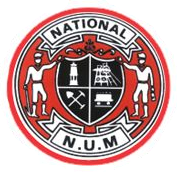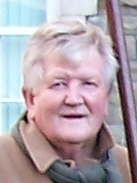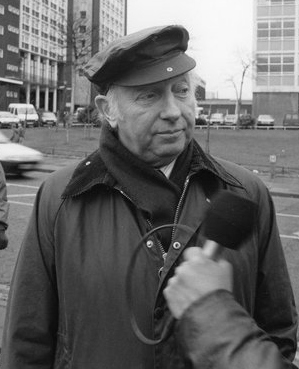
The 1984–1985 United Kingdom miners' strike was a major industrial action within the British coal industry in an attempt to prevent closures of pits that the government deemed "uneconomic" in the coal industry, which had been nationalised in 1947. It was led by Arthur Scargill of the National Union of Mineworkers (NUM) against the National Coal Board (NCB), a government agency. Opposition to the strike was led by the Conservative government of Prime Minister Margaret Thatcher, who wanted to reduce the power of the trade unions.

The Battle of Orgreave was a violent confrontation on 18 June 1984 between pickets and officers of the South Yorkshire Police (SYP) and other police forces, including the Metropolitan Police, at a British Steel Corporation (BSC) coking plant at Orgreave, in Rotherham, South Yorkshire, England. It was a pivotal event in the 1984–1985 UK miners' strike, and one of the most violent clashes in British industrial history.

The National Union of Mineworkers (NUM) is a trade union for coal miners in Great Britain, formed in 1945 from the Miners' Federation of Great Britain (MFGB). The NUM took part in three national miners' strikes, in 1972, 1974 and 1984–85. Following the 1984–85 strike, and the subsequent closure of most of Britain's coal mines, it became a much smaller union. It had around 170,000 members when Arthur Scargill became leader in 1981, a figure which had fallen in 2023 to an active membership of 82.
The Union of Democratic Mineworkers (UDM) was a British trade union for coal miners based in Nottinghamshire, England, established in 1985, following the 1984–85 miners' strike, when the Nottinghamshire Area of the National Union of Mineworkers (NUM) was involved in a number of disputes with the National Executive Committee that led to a split from the NUM. In ballots on joining with Nottinghamshire in a new union, the South Derbyshire Area of the NUM voted in favour by 51% and the Colliery Workers and Allied Trades Association by almost 100%.
Roger Edward Windsor was chief executive of the National Union of Mineworkers (NUM) between 1983 and 1989, including during the 1984 miners' strike. He later moved to France and then to Herefordshire.
Sir Ian Kinloch MacGregor, KBE was a Scottish metallurgist and industrialist. He worked in the United States from World War II until the early 1970s. He is most famous in the UK for his controversial tenure at the British Steel Corporation and his conduct during the 1984–85 miners' strike while managing the National Coal Board.
Joseph Gormley, Baron Gormley, OBE was President of the National Union of Mineworkers from 1971 to 1982, and a Labour peer.

The National Association of Colliery Overmen, Deputies and Shotfirers (NACODS) is an organisation representing former colliery deputies and under-officials in the coal industry.
David James Wilkie was a Welsh taxi driver who was killed during the miners' strike in the United Kingdom, when two striking miners dropped a concrete block from a footbridge onto his taxi whilst he was driving a strike-breaking miner to work. The attack caused a widespread revulsion at the extent of violence in the dispute. The two miners were convicted of murder but the charge was reduced to manslaughter on appeal, becoming a leading case on the issue of the difference between the two offences.

Tyrone O'Sullivan was a Welsh trade unionist who was Branch Secretary of the National Union of Mineworkers (NUM) and Chairman of Goitre Tower Anthracite Ltd., the owners of Tower Colliery.

David Hart was an English writer, businessman, and adviser to Margaret Thatcher. He also had a career in the 1960s as an avant-garde filmmaker. He was a controversial figure during the 1984–85 miners' strike and played a leading role in organising and funding the anti-strike campaign in the coalfields.
The Kent Miners' Association was a trade union in the United Kingdom which existed between 1915 and 1945, representing coal miners in the county of Kent. After 1945 it was reorganised as the Kent Area of the National Union of Mineworkers.
Sir Sidney Ford, MBE was a British trade union leader.
The 1972 United Kingdom miners' strike was a major dispute over pay between the National Union of Mineworkers (NUM) and the Conservative Edward Heath government of the United Kingdom. Miners' wages had not kept pace with those of other industrial workers since 1960. The strike began on 9 January 1972 and ended on 28 February 1972, when the miners returned to work. The strike was called by the National Executive Committee of the NUM and ended when the miners accepted an improved pay offer in a ballot. It was the first time since 1926 that British miners had been on official strike, but there had been a widespread unofficial strike in 1969.
The Cumberland Miners' Association was a trade union in the United Kingdom.

Arthur Scargill is a British trade unionist who was President of the National Union of Mineworkers (NUM) from 1982 to 2002. He is best known for leading the 1984–1985 UK miners' strike, a major event in the history of the British labour movement.
George Bolton is a Scottish former trade unionist and communist activist.
The 1969 United Kingdom miners' strike was an unofficial strike that involved 140 of the 307 collieries owned by the National Coal Board, including all collieries in the Yorkshire area. The strike began on 13 October 1969 and lasted for roughly two weeks, with some pits returning to work before others. The NCB lost £15 million and 2.5 million tonnes of coal as a result of the strike.
Nicky Wilson is a British trade unionist.
Sidney Vincent was a British trade union leader.








